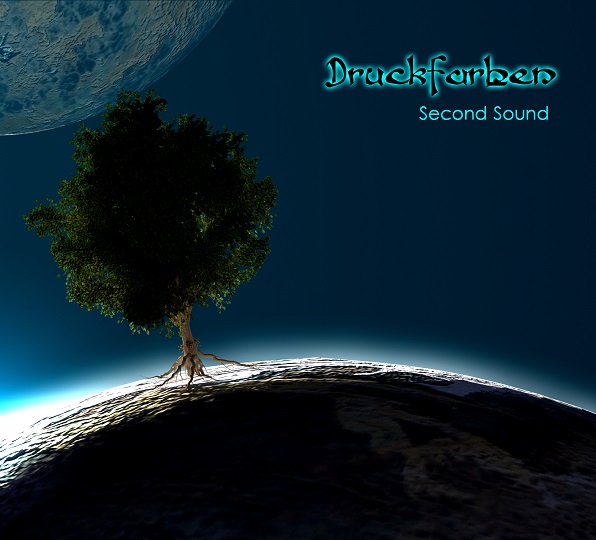
T-Mak’s Intro: “A few years ago I decided to start a classic rock website to review local shows and interview musicians willing to partake in my madness. Honestly, the best thing about starting T-Mak World is meeting and speaking with musicians whose talent is off the charts and whose creativity would put most of us to shame. I asked one of these musicians, whom I knew loved Prog, if he would like to review a CD for fun. Below is a review from Tyrone Buccione the vocalist and guitarist from Toronto’s TimeGiant (I have called TimeGiant the successor to Toronto’s hard rock throne in the tradition of Rush, Max Webster and Triumph). Below is Buccione’s review of Toronto’s Druckfarben’s Second Sound CD. Take it away T-Bone.” – Terry (T-Mak) Makedon
March 28 2014 – Druckfarben is a progressive rock band from Toronto, consisting of Phil Naro (vocals, acoustic guitar), Ed Bernard (guitars, vocals, violins, violas, mandolins, bnajo, dobro, pint glass and incidentals), Will Hare (piano, organ, synthesizers), Peter Murray (bass, vocals) and Troy Feener (drums, percussion). I am thrilled to review their sophomore album, Second Sound, featuring some of Toronto’s finest musical talent, which embraces the perpetually evolving genre known as progressive rock and roll. Though progressive rock (or “prog” rock) has diversified stylistically over the decades since its overly debated 1967 mainstream birth with The Beatles’ Sgt. Pepper’s Lonely Hearts Club Band, prog purists Druckfarben have been discernibly influenced by the 1970’s popular giants of the era. Within a minute of Track 1, sounds reminding me of Genesis, Gentle Giant, and Emerson, Lake and Palmer come crashing in, assuring me that I would be in great company for the rest of the album. As a tried and true Pink Floyd and Yes fan for over 10 years now, I am glad to share my tastes and dig into the record with you.
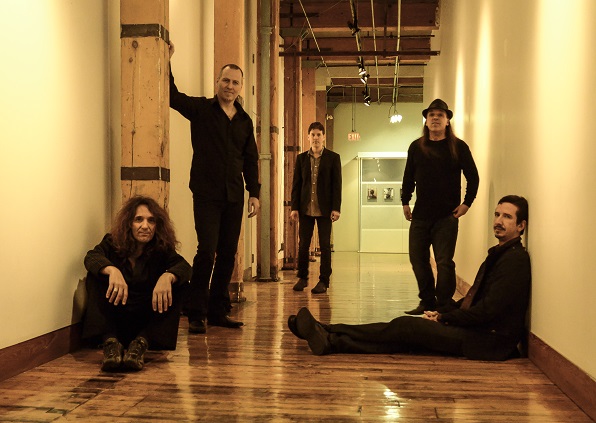
Track 1 – An Answer Dreaming
The album kicks off with a flurry of eighth notes from Hare, eventually landing into the beefy, time signature bending riff delivered by Bernard. Immediately the listener is aware that the bass and drum section isn’t just along for the ride; their foundational rhythm is worthy of its own solo section. About two minutes into the song we hear Naro modestly enter the scene with his signature angelic vocal, uncannily similar in timbre to Yes’ Jon Anderson with wisps of Supertramp’s Rodger Hodgson and Rush’s Geddy Lee. A nice little melodic vocal breakdown accented by Feener’s Alan White-esque china cymbal tones swells and breaks to a big (at least) three part harmony wave of a chorus, elevating the song to a status that makes me want to quit playing music. ‘An Answer Dreaming’ is one of my favourite tracks on the album and it gives the listener a technical overture of what to expect from the band and of the vocal range that is available to the singer. Druckfarben tell us right away that rock and roll is here to stay.
Track 2 – In Disbelief
As we seamlessly crossfade into track two’s Egyptian synth sounds, we are dosed with some organ tones and rhythms reminiscent of Tony Banks’ work on Genesis’ ‘Eleventh Earl of Mar.’ This tune takes the cake for me melodically, stylistically and just plain ol’ rockin-ly. It also leaves lots of “head”room lyrically to digest phrases such as, “freedom is just a word for damn it all” and “everything here can go wrong.” Aside from the obvious title track ‘Second Sound,’ I think this song has some of the most tasteful melodies and lead guitar tones on the album. The only bad part about it was that it lasted a mere 3 and a half minutes. Sad face.
Track 3 – Dandelion
Prog albums = tons of crossfading into new songs = the last song was really composed of the last two songs before it = my favourite track, ‘In Disbelief,’ is really just part of one big intro rock movement = happy face. What an evil riff to kick off such an innocently titled song! The tune unfolds a tone that could have well been recorded from a snake charmer’s pipe, seducing a cobra to rise from its wicker thatched basket. And then following the great trend of prog segues, Druckfarben reaches another lead tonal feature that sounds like a guest electric violinist bowed into the recording studio. Naro arrives with a vocal melody reminding me of Gentle Giant’s ‘Proclamation,’ keeping the lower octave and root third harmonies along for the ride in his vocal sidecar. I really enjoyed ‘Dandelion’ on my second listen, and as with Yes’ ‘Close to the Edge’, these idea-rich songs are usually the ones that keep me coming back for more.
Track 4 – Liberated Dream
Looking at my notes from my first listen of ‘Liberated Dream,’ I wrote the following: “funky riffs. WOO,” and “superbadass back to back organ/guitar solos. Face melting.” My direct transcription of this review is going to be, “Funky riffs. WOO. Superbadass back to back organ/guitar solos. Face melting.” Oh, and I absolutely love the Chris Squire-esque bass solo near the end of this song by Murray. I will leave it at that.
If you fancy take a break from the review and check out the T-Mak World produced Druckfarben Second Sound – In The Studio documentary.
Track 5 – Long Walk Down
Within 30 seconds I knew I would like ‘Long Walk Down’ because it offered something completely different to me after what seemed a four song intro buffet of heavier electric rock and roll (but like, Mandarin buffet. Only the best). The intro piano, simple and delicate, brought back memories of Tony Banks’ ivory-tinkling on ‘Firth of Fifth’ and Rodger Hodgson’s masterpiece ‘Fool’s Overture.’ I also enjoyed the first singer’s vocals and how Naro compliments them with his counterpoint melodies. Great chorus as well here when Naro grabs the mic, taking me back to headphones in my room pumping Yes’ ‘Turn of the Century.’ This one is a beauty that climaxes to a musically euphoric apex and an album gem that certainly gives up some strong English charm. DAMN I love those Tony Banks synth tones, Will. Virtual high five!
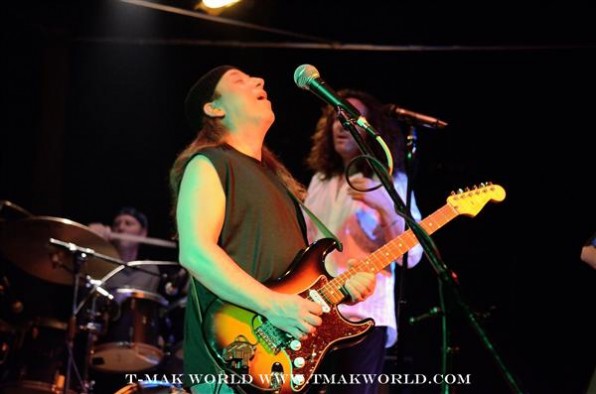
Track 6 – Surrounds Me
I enjoyed delivery of the chorus on ‘Surrounds Me’ as Naro breaks away and jumps into his high register to deliver the title statement. There are nice little guitar paintbrush strokes with slide techniques in the intro over the very impressive canvas of the rhythm section; this later develops into what seems a physically demanding presentation of rock and roll virtuosity. ‘Second Sound’ is definitely the highlight track for the musos out there, as it is laden with riffs, passages, time changes and trading instrument solo features (not to mention the barn burner of a guitar lead from Bernard.) Soon follows a nice Genesis-y breakdown and an explosion into the final, booming chorus.
Track 7 – Another Day
‘Another Day’ starts with a pretty 12 string introduction and a lot of vocal harmonies with counterpoint melody; this is reminiscent of like the recitative Gregorian chant vocal style familiar to Gentle Giant. Druckfarben then break into a more modern style of progressive instrumental and show their mettle by featuring the talented players one at a time (this one really reminded me of a good old fashioned Emerson Lake and Palmer instrumental jam section). I really dug the final bend-y and harmonized guitar solo and the refreshing a capella vocals at the very end.
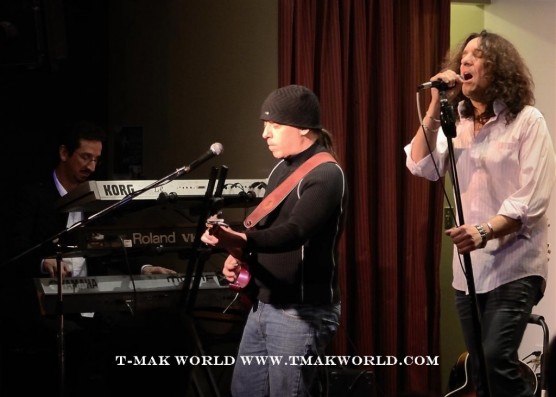
Track 8 – Second Sound
The final sounds of ‘Another Day’ lead nicely into the album’s monster track, ‘Second Sound.’ Clocking in at just under 19 minutes, we would assume that this would take up all of side two, should this recording be printed on vinyl (as I’m sure it will be… or else…) We hear a return of the violin/fiddle tones from ‘Dandelion’ but the rhythm takes it into a more Irish Celtic territory. You can almost smell the spilled Guinness and peanut shells on the pub floor! Naro channels his modern Geddy Lee for the first verse then erupting into his high register for some swelling and descending vocal lines; this takes the listener over a melodic cataract and establishes the main theme to navigate the waters ahead. The acoustic and vocal breakdowns are just brilliant and you realize that the lyrics are well crafted and fit in perfectly with what is going on around the vocalist. You also see that when it’s Naro’s turn to sing, his voice commands the respect that gets the rest of the band to open up to the big, relaxed chords for him to paint on. We soon hear a banjo to close the section off and I wonder how much cooler Mumford and Sons would be with a more tasteful guitarist like Bernard.
Then enters the WICKED Steve Hackett-esque, dreamy guitar solo. Love the tone here but it was way too short! Ed, how did you find that tone that makes me jealous so? I bet you had a Muff and buckets of reverb, didn’t you? DIDN’T YOU?!
The song continues with an elegance that makes me want to applaud producer Steve Major for his excellent ear. He somehow captured the essence of those 70’s recordings without losing the soul of the band.
Next we hear some trippy rhythmical sounds that remind me of Floyd’s ‘Atom Heart Mother’ breakdown before returning to a reprise of the first themes we heard over ten minutes ago. After we hit the zenith of prog beauty following organ arpeggios and tom rolls straight out of the book of Bonham, we finally hit the concluding acoustic theme. What a nice way to end such a powerful album, with Naro singing the final lyrics of Second Sound’s epilogue.
Verdict: What a great album! I give this bad boy 5/5 stars for just being a bold and powerful progressive rock album with track crossfading and killer tones and another 5/5 for having such amazing written parts and melodies. That’s right 10/5 stars! This one will be getting a bunch of play on my iPod and I can’t wait to see the thing performed in its entirety. {Ed. Note – Sorry Tyrone I dont have a 10 out of 5 star logo, so I will have to use a 5 out of 5 with a “Best of T-Mak World Award!}
What I love most about albums such as Queen’s A Night at the Opera and Mike Oldfield’s Tubular Bells, is how diverse they are; the songs themselves are able move through a handful of musical styles while the album track listing can take you on an emotional rollercoaster ride with almost no warning as to what is around the next bend. I always enjoy how the purposefully period-dated old-western acoustic sounds of the song ‘’39’ by Queen could be followed by the balls-to-the-walls rocker ‘Sweet Lady’ immediately afterwards. It was a freedom that musicians had before record labels tried to shape the sausage grinder of radio rock that we hear today. You can’t record two songs today without hearing the droning criticism of “stick to your genre. I can’t tell if you’re rock or if you’re roll. If you’re active rock or alternative rock.” I feel this freedom of musical expression in the mainstream consciousness is an art form which was lost with the early era of vinyl LP’s, and somewhere along the way, being experimental to just make great sounding music and songs a-la Beatles formula became too “far out” and “progressive.” With patience, I realized that Pink Floyd’s Dark Side of the Moon didn’t have to be labeled “progressive” for it to sell millions of copies and remain on the Billboard charts for over 740 consecutive weeks. It was just rock. Guaranteed that 9/10 of those kids with that vinyl in 1973 wouldn’t call it “prog,” they would probably just say it was “…dude…far out dude” (Direct quote, Terry Makedon circa 1973.){Ed. Note – Ha Ha – you are correct but we used to say “man”, not “dude”}
I thought Druckfarben’s Second Sound really captured the true essence of rock and roll, and I know it will be well received in the rock community. Well done guys, truly inspiring stuff! I can’t wait to own a vinyl copy! It’s albums like these that inspire me to push on with my musical passions and assure me that the art form is still alive and well.
Review by Tyrone Buccione of TimeGiant
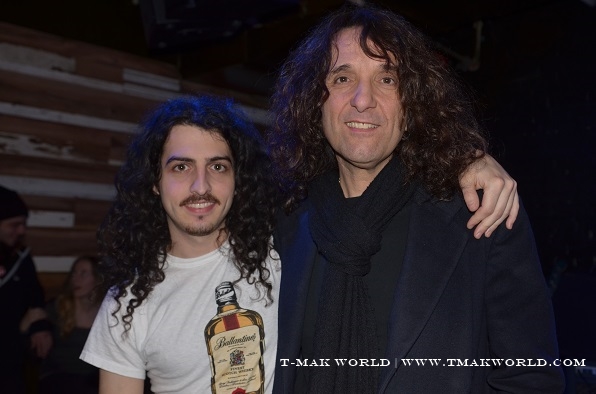

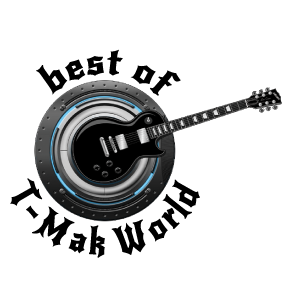

OH! Buccione! You make this paesane proud!
Edwardo Barbalinardo.